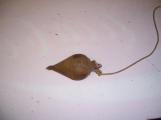14
The Ox and Sled
March, 1973

15
Later oxen and shaft sleds were used to transport logs. By using the oxen, the amount of human energy was greatly reduced. The ox was hooked up to a sled by a contraption consisting of a collar, belly strap, back pad, back rope, breeching, tracer and a head rope.
16
Peavey and Pick Pole
1920
Milltown-Head of Bay d'Espoir Museum, Milltown, Bay d'Espoir, NL, Canada
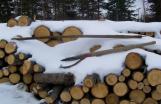
17
Another method of getting logs out of the woods was by driving them down rivers. The teams that did the drives were the main crew and the sack crew. The main drivers consisted of a dozen men to drive the main bulk of the wood and to clear jams, as they occurred, using a peavey or pick pole. The sack crew followed behind the main crew freeing up wood that got caught in the river and cleaning up logs and other debris along the shoreline. The peavey is a wooden pole, five or six feet long with a strong steel spike and adjustable steel hook at one end, used for turning logs. The pick pole is a 10 to 16 foot long pole with a metal tip. Loggers drove the tip into a log to push or pull it.
The logs were "rafted" down stream to the mills. "Rafting" consisted of laying 25 logs side by side and tying them together and then hauling them to the mill by boat where they would be manufactured into lumber.
18
During these years, tools for shipbuilding were very limited. The most common tools used were the axe, adze and caulking iron. The axe was used for framework and the adze (an axe-like tool with its blade at right angles to the handle) was used for shaping the wood.
19
Mallet
1920
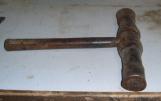
20
When all the framework was finished, the seams of the vessels had to be caulked or corked to make them watertight and seaworthy. This was accomplished by striking a mallet to a caulking iron (oakum punch) to fill the seams on the decks and sides with oakum (oakum was produced by picking apart old ropes and steeping them in pine tar).
21
Caulking Irons
1920
Milltown-Head of Bay d'Espoir Museum, Milltown, Bay d'Espoir, NL, Canada
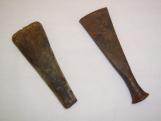
22
The caulking iron was a triangular shaped tool that was made from iron or whale bone. It had a thin edge to fit in the seams and a head that you would strike with a mallet.
23
Gauge Marker
1920
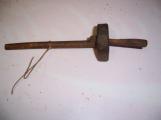
24
A marking gauge was used to mark the wood for cutting. The gauge was set to the desired width and as one end followed the edge of the wood the other created a line with a nail.
25
Shipbuilding Auger
1920

26
A shipbuilding auger was used to drill holes for screws or plugs so they could be placed into the planks. This type of auger had a wooden handle and spiral bit. By using the auger to drill a deep hole, the screw or plug could be placed into the wood far enough so that these holes could be filled.
27
Plumb Bob
1920
